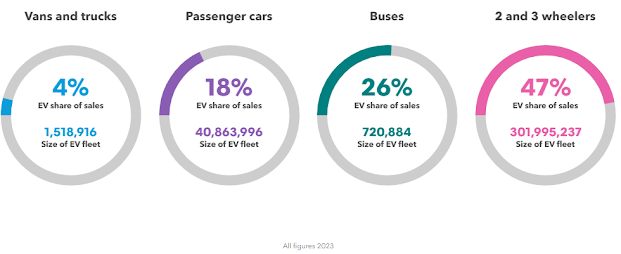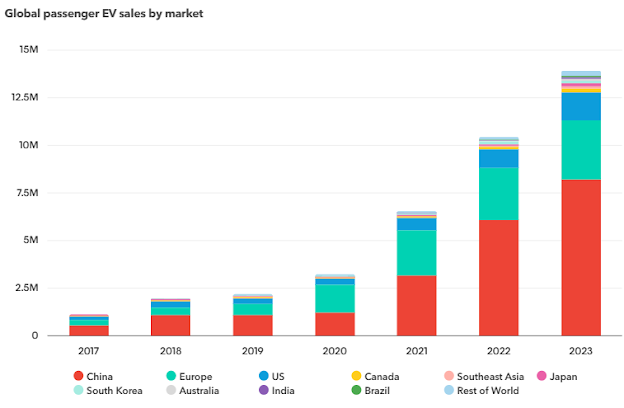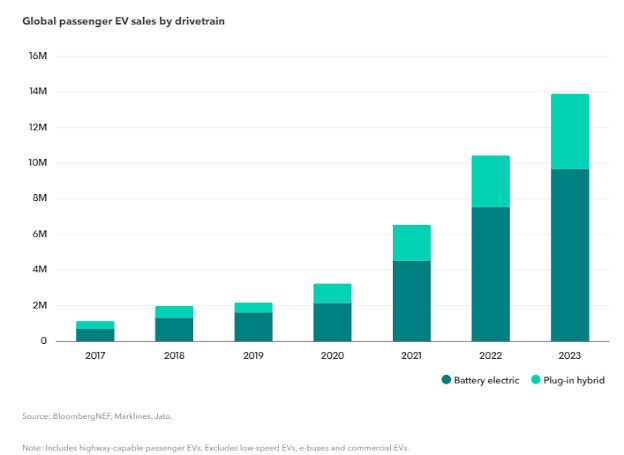Alright! let’s have a discussion about electric vehicles (EVs). We’ve got a vision, a dream if you will, of a world powered by clean energy, where the hum of electric motors replaces the roar of gasoline engines. Imagine zipping around in sleek, silent vehicles, breathing in fresh, unpolluted air in our cities, and knowing we’re playing our part in a healthier planet. That’s the future we see on the horizon with the EV adoption curve.
But lately, the journey hasn’t been as smooth as we’d hoped. Just the other day, we were reading the Electric Vehicle Outlook 2024 report from Bloomberg NEF. It hits home that while global EV sales are still climbing, some markets are hitting the brakes, and big automakers are even rethinking their EV timelines.


It’s like we’ve hit a bit of a speed bump on our way to that electric future.
So, what’s causing this wobble in the EV adoption curve? Let’s break it down:
- Money matters: Let’s face it, EVs can still be pricey for many people. The price gap between EVs and traditional gas guzzlers is a big hurdle, especially in places where government support is shrinking. As Laurence Noël from Capgemini pointed out in a Forbes article, demand in Europe dipped after incentives were reduced.
- Where do I plug in? The charging situation is still a headache for many. People worry about finding a charger when they need one, especially on long trips. A Forbes article on EV highlights that building reliable, widespread charging networks is crucial to squash this “range anxiety” and build consumer trust. Plus, even when you find a charger, it’s not always a smooth experience with malfunctioning stations and tricky payments being a common complaint.
- Battery blues: People still have questions about how far an EV can go on a single charge, and what happens to the battery in cold weather. Are we ready for this tech? Some individuals are just not that familiar with EVs and the whole charging process. The McKinsey Mobility Consumer Pulse 2024 overview points out that many EV skeptics have low familiarity with the technology. Some even just really enjoy driving a good old combustion engine car!
Now, we truly believe that this utopian vision we painted at the start isn’t just a pipe dream. If we tackle these roadblocks head-on, we can get back on that smooth, upward EV adoption curve.

The demand is still there; we just need to make the switch easier and more appealing for everyone.
So, what can we do about it? Here are some ideas:
- Making EVs more wallet-friendly:
- Governments should think about smart incentives that really help people afford EVs.
- The industry needs to keep pushing for lower battery costs, which will bring down the overall price of EVs. Bloomberg NEF shows the difference in Lithium iron phosphate (LFP) battery cell prices between the global average and China in 2023-2024, illustrating the potential for cost reduction.
- Exploring different ownership models like vehicle subscriptions could also make EVs more accessible.
- Supercharging the charging infrastructure:
- Massive investment in public charging networks, especially fast chargers on highways, is a must. We need reliable and easy-to-use charging stations with clear information on availability and pricing.Public-private partnerships can be a game-changer in building out this infrastructure efficiently.Learning from more mature EV markets like Europe can give us valuable insights.
- Real-time data sharing across the industry is crucial for better e-Mobility apps that guide drivers to available chargers.
- Boosting battery confidence:
- Continued innovation in battery technology to improve range, charging speed, and performance in all weather conditions is key.
- Clear communication and education about battery life and replacement can ease consumer worries.
- Getting everyone on board:
- Educational campaigns to bust myths about EVs and highlight their benefits are important.
- Automakers and the industry need to really understand what consumers want and deliver on those needs.
- Smart government policies:
- Governments need to create clear and consistent long-term policies that support the EV transition.
- Focusing on infrastructure development might have a more lasting impact than just short-term incentives.
What are your thoughts on all this? Have you experienced any of these challenges yourself? What do you think are the best ways to get the EV adoption curve back on track? Let’s hear your opinions in the comments below!
(At Zamun, we specialize in smart, data-driven marketing solutions tailored to the evolving EV landscape. As adoption patterns shift and consumer expectations evolve, our strategies help you stay ahead of the curve—driving awareness, engagement, and conversions. Partner with Zamun to power up your presence in the electric mobility space.We offer a range of marketing and branding services, led by top professionals who have decades of experience. To know more about how we can take your organization to a higher orbit, visit Our Services Page or drop in an email to connect.)
FAQs
EV sales are slowing due to a mix of factors—rising prices, limited charging infrastructure, and shifting consumer expectations. People want better value and convenience.
Clear messaging, trust-building, and solving real consumer concerns—like range anxiety and cost—are key. It’s all about better education and smarter outreach.
Good marketing helps you stay visible, build credibility, and connect with the right audience. It’s not just about ads—it’s about storytelling and trust.
Zamun offers tailored marketing strategies that address today’s EV buyer mindset—from digital campaigns to brand positioning. We help you drive real results in a shifting market.
Glossary
LFP Batteries: Lithium iron phosphate (LFP) battery: The lithium iron phosphate battery (LiFePo4 battery) or LFP battery (lithium ferrophosphate) is a type of lithium-ion battery using lithium iron phosphate (LiFePo4) as the cathode material, and a graphitic carbon electrode with a metallic backing as the anode). LFP batteries are finding a number of roles in vehicle use, utility-scale stationary applications, and backup power.
